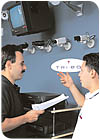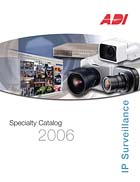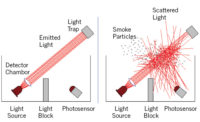
Technology advances have driven above-market growth in video surveillance in recent years. Along with that growth have come some changes in how video surveillance products are bought and sold. In this article, we explore seven key trends.
Along with the above-market growth in video surveillance in recent years has come some changes in how video surveillance products are bought and sold. In this article, we explore seven key trends.
New Types of Dealers
Video’s strong growth has attracted new types of companies to the video installation business. “Most of the home automation companies are getting more involved in CCTV,†notes John Hyatt, U.S. systems sales manager for Tri-Ed Distribution Inc., Woodbury, N.Y. “Many cameras have a Category 5 connection, and these people are already running Cat 5 wiring.â€
New Types of Distributors
When new types of companies get into the video surveillance business, they often look to their traditional suppliers for equipment, which is also driving new types of companies to distribute video equipment.
“We get calls every week from people in and outside of the industry wanting to know how to get in – not just manufacturers, but distributors,†notes Sandra Jones, principal of Sandra Jones & Company, Chardon, Ohio, a consulting firm specializing in the security industry.
Distributors that would traditionally handle computer or audio equipment are among the companies that have begun to take an interest in video surveillance, she adds.
Electrical distributors also have gotten into the act, notes Gary Venable, owner of systems integrator Systems Designed Solutions, Kansas City, Kan., and chairman of the board of PSA Security Network, an organization that specializes in supporting security systems integrators.
More IT Involvement
Increasingly, today’s video systems are using Ethernet networks for communications, which has led business customers’ information technology personnel to become involved with and in some cases to drive video surveillance decisions.
This development is causing some systems integrators to emphasize a team-selling approach and to make sure that at least one person on the team has a strong knowledge of computer networking.
“Salespeople used to know everything about what they were selling,†notes Venable. “Now they need a technical person to support them.†Systems Designed Solutions calls these support people “technical managers.â€
A typical technical manager might come out of the company’s service or project management department. Such employees are in a continuous training process, attending factory training programs and receiving networking certifications.
“It adds to overhead and takes up time,†Venable notes. But having such employees on staff increasingly is becoming “table stakes†in selling video surveillance to medium and large enterprises.
Smaller installing companies that may not have the resources to keep a networking specialist on staff increasingly are turning to their distributor to play that role.
“Education is a key component to understanding IT technology,†says Randy Teague, vice president of marketing at ADI, Melville, N.Y. “We must continue to educate our customers – not just the high-end installers, but the everyday installers – on how to sell the capability of the system.â€
ADI provides the specific education and tools necessary to take advantage of the exploding video systems market, Teague says, including its Systems Sales and Support group, new IP Surveillance catalog (shown on facing page), and specialized training at ADI expos and branches that focus on IT.
Tri-Ed often is called upon to participate in sales calls with customers and to provide technical expertise on the call, Hyatt notes. “We’re involved from the first contact with the initial job walk-through to the installation,†he says.
Manufacturers and the sales firms that represent specific manufacturers’ products also are called upon to provide technical expertise, particularly for sales calls to larger accounts.
“We have Microsoft and Cisco-certified personnel,†notes Bill Barthelemy, managing director for Timarron Partners Inc., Grapevine, Texas, a rep firm. “If necessary, we pull them into the sales call.â€
Bathelemy adds that greater IT involvement also has increased the length of the sales cycle because concerns about the impact of the security system on the customer’s computer network must be addressed and because more people must approve the purchase.

The End-User Is King
Most manufacturers and distributors are careful not to sell directly to end-users. They realize that if they sell directly to the customers of their wholesale accounts, they will lose those accounts. Increasingly, however, both manufacturers and distributors are in direct contact with end-users of video surveillance equipment.
“The days of customers putting out a bid to four different integrators and getting four different solutions are gone,†notes Tom Heiser, director of access and video systems product management for manufacturer Tyco Fire and Security, Boca Raton, Fla. “Customers are spending more time talking to manufacturers to understand their needs so that when they go to bid, they have a better understanding of what they need.â€
In some cases, Heiser says, a systems integrator will invite Tyco to visit a potential customer to have the kind of discussion to which Heiser refers. In other cases, Heiser says, the end-user makes the contact with Tyco and along with providing technical guidance, Tyco refers the customer to qualified integrators in the area.
Some manufacturers use independent sales firms to handle sales of their product, and increasingly, these rep firms also are finding direct contact with end-users to be a critical part of the sales process.
Brainerd-Nielsen Marketing, Elk Grove, Ill., a rep firm, has one person on its staff who is dedicated to marketing to end-users and to the architects and engineers who often write the technical specifications for organizations purchasing video surveillance systems.
The company regularly markets to a database of end-user organizations, informing them, for example, when a new product is introduced by one of the manufacturers that the firm represents.
“Everyone in our database is qualified,†notes Paul Nielsen, Brainerd-Nielsen’s owner/president. “Our salespeople are expected to keep the database up-to-date.â€
LCA Sales, Hawthorne, N.Y., is another rep firm that often has direct contact with end-users. “If I see a spec that doesn’t have my product, I’ll contact the consultant who wrote it and find out why he chose that particular product,†notes LCA sales manager Steve Keech. “Traditionally, our role has been that of someone who services the dealer network, including distributors.
“But over the last several years, our role has also evolved into trying to create more demand for our product by working with consultants and large end-users to educate them about our products and their advantages,†Keech explains. “The influx of manufacturers entering the market has put manufacturers in a position where they’re all looking to influence the decision-maker, who may be the end-user or a consultant.â€

‘Co-opetition’
As with organizations everywhere, many end-users are seeking ways to save time and resources and streamline their operations. Increasingly, this means they want to have a single point of contact for their video equipment needs.
This, in turn, is giving rise to a phenomenon that Jones calls “co-opetition,†which refers to a situation in which two companies are competitors in some areas but partners in other areas.
“In the past, each manufacturer was a specialist in a certain area, but today, each manufacturer has expanded the breadth of its capabilities,†Jones points out. “We’re seeing a greater move toward alliances. Many manufacturers are private labeling and marketing each other’s products.â€
In addition, among distributors the trend is to provide value-added services. “Value-added distributors are important because they can pull together all the pieces of the solution,†ADI’s Teague notes. “For example, whereas highly specialized manufacturers are important to solutions, such as wireless or mesh network video, co-opetition with distributors is ideal because distributors can look at the entire scope of the project – not just one component.â€

The effect of the Retail Market
As prices of video equipment have come down – and as retail consumers have become more knowledgeable about technology in general – new video surveillance opportunities are beginning to rise in the retail market. Often such products are sold directly to consumers as do-it-yourself offerings through traditional electronic and computer retailers.
But as manufacturer WiLife, Draper, Utah, has learned, there also seems to be strong demand for a consumer-grade video surveillance product that could be sold through and installed by security dealers.
For example, WiLife offers an entry-level video system that includes an IP-addressable camera and software for a personal computer that was originally designed for consumers to install themselves. By using HomePlug technology, the camera and PC communicate via existing electrical wiring.
The product appeared on the shelves of 2,500 Radio Shack stores in March, but several months before that, it received a write-up in Business Week that generated strong interest from security dealers. (For more information, see SDM, “Power Line Video Surveillance Fills Small Commercial and Residential Niche,†April 2006, p. 51.)
WiLife president Evan Tree, who worked as a security dealer for 20 years before founding WiLife in late 2002, says he used to hate turning away residential users who called to inquire about video surveillance but could not afford anything available at that time.
For that reason, he says, “I knew the product was going to be appealing to the professional dealer, but I had no idea how interested they would be until we started getting multiple requests every day from dealers who saw or read about the product.â€
Currently, WiLife is selling directly to dealers, but later this year the company plans to introduce a product that is a bit more sophisticated that will be sold only to the dealer market, and at that point, the company hopes to begin selling through distributors.
Pricing Pressures
Pricing and margins for video surveillance products are under pressure because a range of offshore manufacturers have entered the market, often with undifferentiated product at low prices.
As computer distributors, which typically operate on narrower margins than security distributors, have gotten more involved with video surveillance, that too has driven prices and margins down.
Tyco’s response has been to package several of its products together as a kit, offering dealers a price break in comparison with purchasing the same items separately. “We’re doing more of that,†notes Heiser, who says that approach provides a solution for price-sensitive dealers while also driving the sale of additional products.
In addition to these seven trends, the folks at ADI have observed a change in the size of the dealer companies selling and installing integrated systems, particularly those involving video systems.
“We are seeing integration at lower levels pushing down into installations where smaller dealers can integrate,†Teague says. “For example, we are seeing cost-effective ways for doctors’ or lawyers’offices to have a four- to eight camera install now integrated with access control. It doesn’t always have to be large scale, like a pharmaceutical company.â€
Side bar: 2 Manufacturers, 2 Different Takes on Distribution
For many years, distributors have played an important role in getting security products to market. Buying through a distributor can save costs by reducing the number of supplier relationships the dealer must administer. It also can help minimize inventory costs, which can run as much as 15 percent to 16 percent of the cost of a job by some estimates.
John Hyatt, U.S. systems sales manager for security distributor Tri-Ed Distribution, Woodbury, N.Y., estimates that about 35 percent of video surveillance products are sold through distributors, a percentage he says has remained constant for several years. The remaining 65 percent are sold directly from the manufacturer to the security dealer or systems integrator.
Some manufacturers sell direct to the largest accounts, while steering smaller dealers to a distributor. But not all manufacturers agree with that approach or on what the split should be.
“We exclusively sell through distribution,†notes Alan Bass, president of manufacturer Digimerge, Markham, Ontario. Digimerge got into the professional video surveillance market just three years ago, although its parent company Lorex has offered a do-it-yourself line through retail outlets for 10 years.
“We felt the best route to bringing our professional line to the market was to partner with the known distributors out there that already had the account base with the dealers,†Bass says. He adds that the company works with six to eight distributors in North America, many of which have multiple branches.
Despite Digimerge’s heavy reliance on distributors, the company also has its own sales force and uses some independent sales representatives.
“Our philosophy is to pull the products through distribution,†Bass declares. The role of the sales force, he says, is “to train branches and call on the dealer and installer base that’s out there and give them a choice of where they can buy our products.â€
Salespeople are expected to spend 20 percent to 25 percent of their time with distributor branches and 75 percent to 80 percent of their time with dealers.
Another video surveillance equipment manufacturer – i3DVR International, Toronto – uses a different approach toward getting its products to market.
“We sell through systems integrators and smaller regional distributors,†notes Dan McGinley, vice president of U.S. sales for the company. “Anytime we refer people to a distributor, we run the risk of losing them,†McGinley says. “By working directly with the systems integrators, we build a lot more loyalty and we’re a lot closer to the sale.â€

